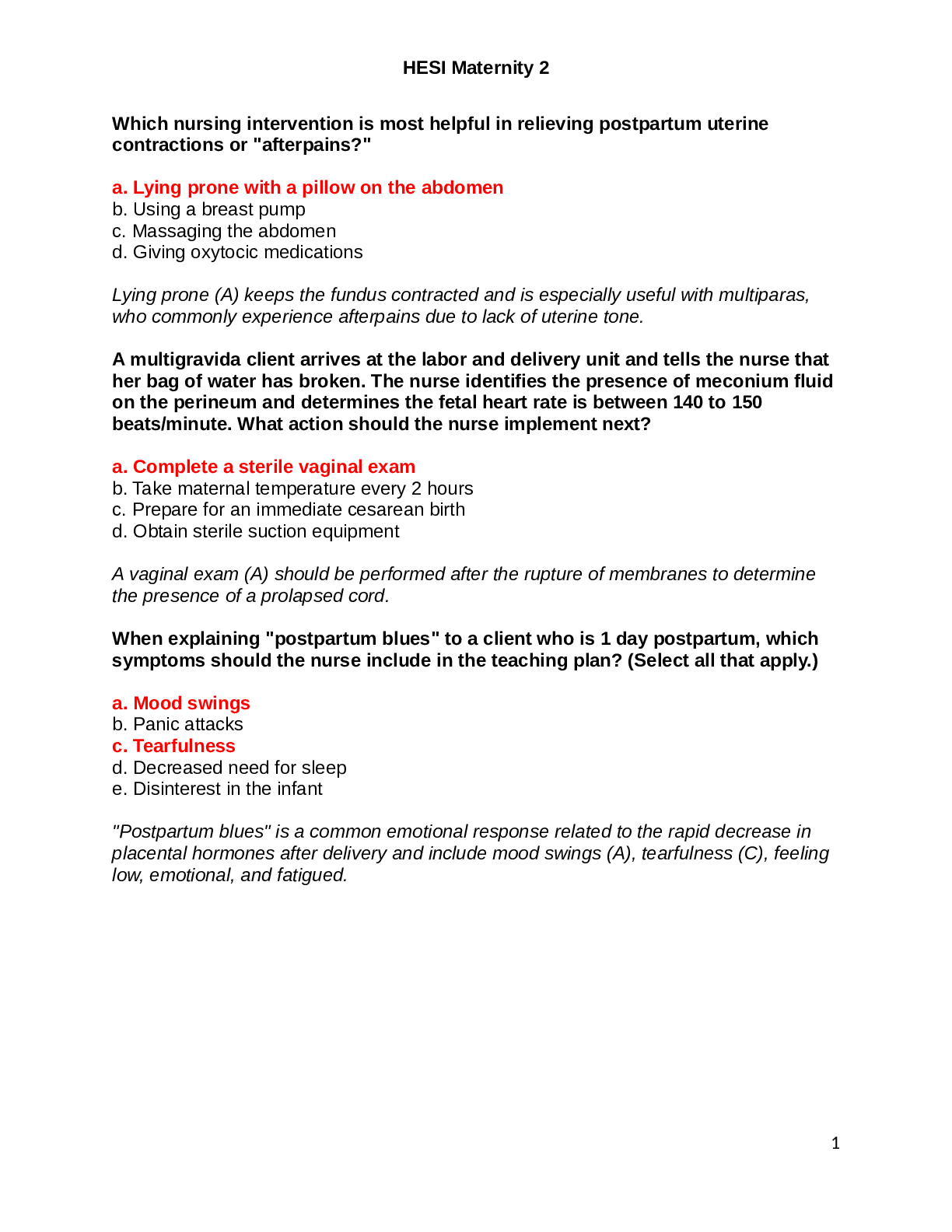*NURSING > QUESTIONS and ANSWERS > Middlesex County CollegeNRB 101Chapter 14- Nursing Management During Labor and Birth (All)
Middlesex County CollegeNRB 101Chapter 14- Nursing Management During Labor and Birth
Document Content and Description Below
1.A woman in labor who received an opioid for pain relief develops respiratory depression. The nurse would expect which agent to be administered? A) Butorphanol B) Fentanyl C) Naloxone D) Prometh... azine Ans: C Feedback: Naloxone is an opioid antagonist used to reverse the effects of opioids such as respiratory depression. Butorphanol and fentanyl are opioids and would cause further respiratory depression. Promethazine is an ataractic used as an adjunct to potentiate the effectiveness of the opioid. 2.A client's membranes spontaneously ruptured, as evidenced by a gush of clear fluid with a contraction. Which of the following would the nurse do next? A) Check the fetal heart rate. B) Perform a vaginal exam. C) Notify the physician immediately. D) Change the linen saver pad. Ans: A Feedback: When membranes rupture, the priority focus is on assessing fetal heart rate first to identify a deceleration, which might indicate cord compression secondary to cord prolapse. A vaginal exam may be done later to evaluate for continued progression of labor. The physician should be notified, but this is not a priority at this time. Changing the linen saver pad would be appropriate once the fetal status is determined and the physician has been notified. 3.A woman has just entered the second stage of labor. The nurse would focus care on which of the following? A) Encouraging the woman to push when she has a strong desire to do so B) Alleviating perineal discomfort with the application of ice packs C) Palpating the woman's fundus for position and firmness D) Completing the identification process of the newborn with the mother Ans: A Feedback: During the second stage of labor, nursing interventions focus on motivating the woman, encouraging her to put all her efforts toward pushing. Alleviating perineal discomfort with ice packs and palpating the woman's fundus would be appropriate during the fourth stage of labor. Completing the newborn identification process would be appropriate during the third stage of labor. 4.The nurse notes persistent early decelerations on the fetal monitoring strip. Which of the Page 1 following would the nurse do next? A) Continue to monitor the FHR because this pattern is benign. B) Perform a vaginal exam to assess cervical dilation and effacement. C) Stay with the client while reporting the finding to the physician. D) Administer oxygen after turning the client on her left side. Ans: A Feedback: Early decelerations are not indicative of fetal distress and do not require intervention. Therefore, the nurse would continue to monitor the fetal heart rate pattern. They are most often seen during the active stage of any normal labor, during pushing, crowning, or vacuum extraction. They are thought to be a result of fetal head compression that results in a reflex vagal response with a resultant slowing of the FHR during uterine contractions. There is no need to perform a vaginal exam, report the finding to the physician, or administer oxygen. 5.A woman is admitted to the labor and birthing suite. Vaginal examination reveals that the presenting part is approximately 2 cm above the ischial spines. The nurse documents this finding as: A) +2 station B) 0 station C) –2 station D) Crowning Ans: C Feedback: The ischial spines serve as landmarks and are designated as zero status. If the presenting part is palpated higher than the maternal ischial spines, a negative number is assigned. Therefore, the nurse would document the finding as –2 station. If the presenting part is below the ischial spines, then the station would be +2. Crowning refers to the appearance of the fetal head at the vaginal opening. 6.The nurse is performing Leopold's maneuvers to determine fetal presentation, position, and lie. Which action would the nurse do first? A) Feel for the fetal buttocks or head while palpating the abdomen. B) Feel for the fetal back and limbs as the hands move laterally on the abdomen. C) Palpate for the presenting part in the area just above the symphysis pubis. D) Determine flexion by pressing downward toward the symphysis pubis. Ans: A Feedback: The first maneuver involves feeling for the buttocks and head . Next the nurse palpates on which side the fetal back is located. The third maneuver determines presentation and involves palpating the area just above the symphysis pubis. The final maneuver determines attitude and involves applying downward pressure in the direction of the symphysis pubis. [Show More]
Last updated: 2 years ago
Preview 1 out of 11 pages
.png)
Buy this document to get the full access instantly
Instant Download Access after purchase
Buy NowInstant download
We Accept:

Reviews( 0 )
$7.00
Can't find what you want? Try our AI powered Search
Document information
Connected school, study & course
About the document
Uploaded On
May 08, 2021
Number of pages
11
Written in
Additional information
This document has been written for:
Uploaded
May 08, 2021
Downloads
0
Views
65

.png)




